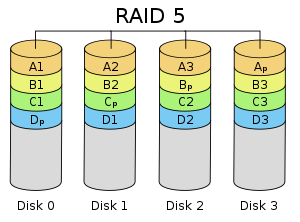Understanding RAID configuration just for reminder cheat sheet
Taken from https://en.wikipedia.org/wiki/Standard_RAID_levels#RAID_6
Important term
Data striping is the technique of segmenting logically sequential data, such as a file, so that consecutive segments are stored on different physical storage devices.



RAID 5 requires at least three disks

Nested RAID levels combine two or more of the standard RAID levels
Important term
Data striping is the technique of segmenting logically sequential data, such as a file, so that consecutive segments are stored on different physical storage devices.
RAID 0 data evenly across two or more disks, without parity information, redundancy, or fault tolerance. Minimum no of drives 2
Best for :
RAID 0 is normally used to increase performance, although it can also be used as a way to create a large logical volume(large size disk) out of two or more physical disks
A RAID 0 array of n drives provides data read and write transfer rates up to n times as high as the individual drive rates, but with no data redundancy.

Minimum no of drives 2
RAID 1 consists of an exact copy (or mirror) of a set of data on two or more disks; a classic RAID 1 mirrored pair contains two disks. This configuration offers no parity, striping, or spanning of disk space across multiple disks, since the data is mirrored on all disks belonging to the array, and the array can only be as big as the smallest member disk.
Total storage size = size of smallest member disk.
This layout is useful when read performance or reliability is more important than write performance or the resulting data storage capacity

Minimum no of drives 3
It stripes data at the bit (rather than block) level, and uses a Hamming code for error correction.
Only advantage is that depending on a high rate Hamming code, many spindles would operate in parallel to simultaneously transfer data so that "very high data transfer rates" are possible.
Not used anymore

Minimum no of drives 3
Not used anymore. RAID 3 was usually implemented in hardware
suitable for applications that demand the highest transfer rates in long sequential reads and writes, for example uncompressed video editing
I/O operation requires activity on every disk and usually requires synchronized spindles.
This makes it suitable for applications that demand the highest transfer rates in long sequential reads and writes, for example uncompressed video editing. Applications that make small reads and writes from random disk locations will get the worst performance out of this level.
RAID 4 provides good performance of random reads, while the performance of random writes is low due to the need to write all parity data to a single disk
Minimum no of drives 3

write performance is increased since all RAID members participate in the serving of write requests
RAID 6 extends RAID 5 by adding another parity block; thus, it uses block-level striping with two parity
Diagram of a RAID 6 setup, which is identical to RAID 5 other than the addition of a second parity block.
Blocks distributed across all member disks.
Minimum no of drives 4
RAID 6 does not have a performance penalty for read operations, but it does have a performance penalty on write operations because of the overhead associated with parity calculations.
Performance will depend on how manufacture have implemented software or firmware to increase calculation of double parity check.
It is update over RAID 5
RAID 0+1 or RAID 01, RAID 0+3 or RAID 03, RAID 1+0 or RAID 10, RAID 5+0 or RAID 50, RAID 6+0 or RAID 60, and RAID 10+0 or RAID 100
RAID 1+0 or RAID 10
RAID 10 provides better throughput and latency than all other RAID levels except RAID 0 (which wins in throughput). Thus, it is the preferable RAID level for I/O-intensive applications such as database, email, and web servers, as well as for any other use requiring high disk performance
RAID 10 provides better throughput and latency than all other RAID levels except RAID 0 (which wins in throughput). Thus, it is the preferable RAID level for I/O-intensive applications such as database, email, and web servers, as well as for any other use requiring high disk performance
Block level striping with mirroring
Total space on array of disk becomes effectively half eg. 4*300=1200 GB will have usable storage of 600 GB
Advantage is good redundancy
Advantage is good redundancy
Note:
Google uses the Google file system Google File System which is a distributed replicated file system. Google file system GFS distributes files in chunks and has master servers which keeps tracks of the chunks.
Good reads on the topic :https://www.ait.com/tech-corner/10681-raid-level-best
https://en.wikipedia.org/wiki/Data_striping



Comments
Post a Comment